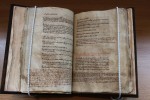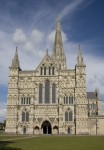 The Register of St. Osmund, a 12th century manuscript recording the foundational documents of Salisbury Cathedral, has been returned to the Cathedral after 34 years. It was a filing mishap that saw one of the Cathedral’s most important historical records leave its home to spend almost four decades in the County Record Office. The book belongs to the Cathedral Chapter under the purview of the Dean of Salisbury, but somehow wound up in the archives of the Diocese, under the purview of the Bishop, instead.
The Register of St. Osmund, a 12th century manuscript recording the foundational documents of Salisbury Cathedral, has been returned to the Cathedral after 34 years. It was a filing mishap that saw one of the Cathedral’s most important historical records leave its home to spend almost four decades in the County Record Office. The book belongs to the Cathedral Chapter under the purview of the Dean of Salisbury, but somehow wound up in the archives of the Diocese, under the purview of the Bishop, instead.
In 1978 the General Synod of the Church of England passed the Parochial Registers and Records Measure which stipulated that non-current parish records should be transferred to the records offices of local authorities where they could be properly cared for by experts. The measure protected the records, ensuring they would be kept in proper archival conditions and handled by professionals rather than church employees who may or may not have any special knowledge in this area, and made church documents accessible to the public for historical and genealogical research.
 In keeping with the Parochial Registers and Records Measure, in 1980 the Diocesan archives were moved from Wren Hall in the Cathedral Close offsite to the County Record Office, now the Wiltshire and Swindon History Centre. The misfiled Register of St. Osmund went with them, nestled amidst the parish’s collection of baptismal records and historical wills from 1540 to 1858.
In keeping with the Parochial Registers and Records Measure, in 1980 the Diocesan archives were moved from Wren Hall in the Cathedral Close offsite to the County Record Office, now the Wiltshire and Swindon History Centre. The misfiled Register of St. Osmund went with them, nestled amidst the parish’s collection of baptismal records and historical wills from 1540 to 1858.
It was archivists at the Wiltshire and Swindon History Centre who finally recognized that the Register belonged in the Cathedral Library and Archives.
The Bishop of Salisbury, the Rt Revd Nicholas Holtam, said “I am delighted to see this ancient document, which somehow got confused with my predecessors’ records, returned to the cathedral. One of the glories of Salisbury Cathedral is the integrity and continuity of its ancient records and it reflects great credit on Wiltshire and Swindon History Centre that they recognized this particular document’s true home and encouraged its return.”
 The Register of St. Osmund was not, as its name implies, compiled by the Saint himself. It’s named after him because it’s a compendium of charters, rules, statutes and rites that he instituted when he was Bishop of Salisbury from 1078 until his death in 1099. Salisbury was called Sarum in his day, and the Sarum Use, the practices regulating the Divine Office, mass and liturgical calendar that Osmund put together from pre-existing Norman and Saxon sources, became hugely influential. It was in widespread use in churches all over the country. Even after the Reformation, the Sarum Use was with some modifications employed in Church of England practices and in fact still is to this day.
The Register of St. Osmund was not, as its name implies, compiled by the Saint himself. It’s named after him because it’s a compendium of charters, rules, statutes and rites that he instituted when he was Bishop of Salisbury from 1078 until his death in 1099. Salisbury was called Sarum in his day, and the Sarum Use, the practices regulating the Divine Office, mass and liturgical calendar that Osmund put together from pre-existing Norman and Saxon sources, became hugely influential. It was in widespread use in churches all over the country. Even after the Reformation, the Sarum Use was with some modifications employed in Church of England practices and in fact still is to this day.
The original manuscript drawn up by Osmund (he was a dedicated bibliophile and did a great deal of copying and book binding personally, so he could have literally put the first register together himself, or he could have ordered it put together by scribes) was lost. The Register includes the earliest surviving copy of Osmund’s Consuetudinary (a book containing the forms and ceremonies of a particular church or monastery), written around 1222-1240 for use in the new Salisbury Cathedral built on the property of Richard Poore when he was Bishop of Salisbury.
 The influence of the Sarum Rite inspired a movement to canonize Osmund as a saint and father of the English church. The first papal bull establishing a preliminary inquiry into Osmund’s potential sainthood was promulgated on May 30th, 1228, by Pope Gregory IX. The inquiry took another 250 years, the repeated interventions of at least two kings of England (Henry V and Henry VI), and the Salisbury chapter to come to fruition. Osmund was canonized on January 1st, 1457.
The influence of the Sarum Rite inspired a movement to canonize Osmund as a saint and father of the English church. The first papal bull establishing a preliminary inquiry into Osmund’s potential sainthood was promulgated on May 30th, 1228, by Pope Gregory IX. The inquiry took another 250 years, the repeated interventions of at least two kings of England (Henry V and Henry VI), and the Salisbury chapter to come to fruition. Osmund was canonized on January 1st, 1457.
Given the major historical import, therefore, of the Register, it’s kind of crazy that they ever lost track of it. Let’s just be grateful it wandered into the county archives for all those years and that it’s back in the Cathedral library now.